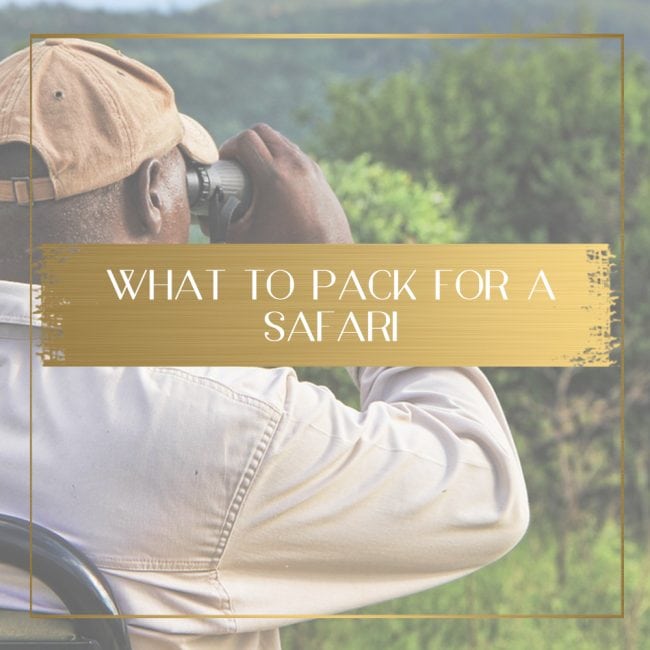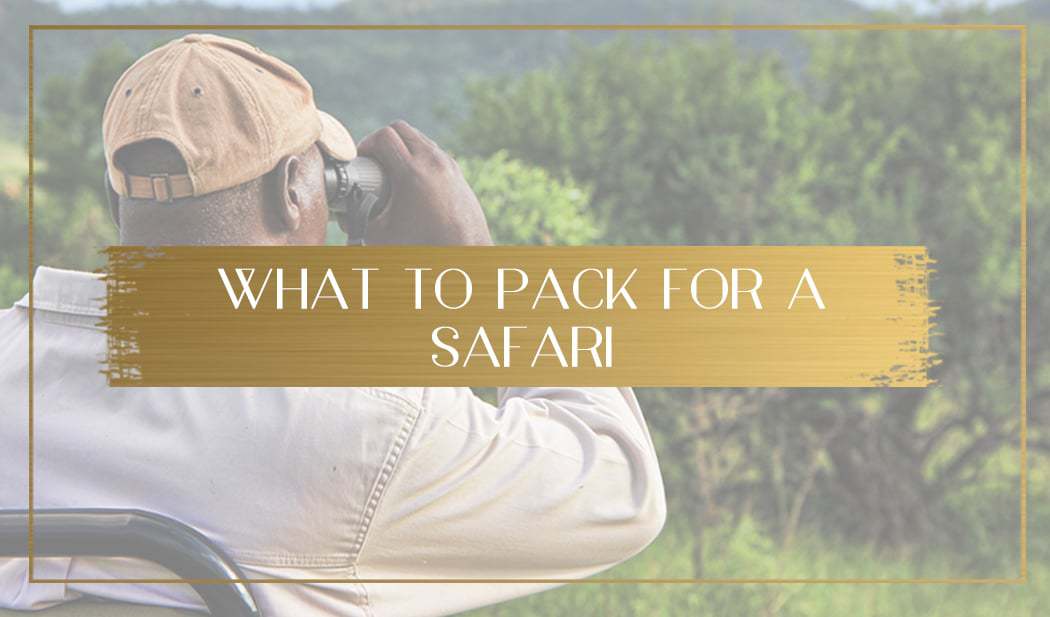Packing appropriately for a vacation is always important but, packing for a safari, is made even more essential by the weight limitations of bush planes and the fact that you won’t be able to pop by a store to buy what you forgot.
The type of safari you are embarking on, the destination and the time of the year are all determining factors for what to pack and what to leave out. I have been on safari in many destinations from Namibia and Kenya to Uganda and even Sri Lanka – so you can trust me with this list. Here is a guide to make you think about all the possible items you need to pack for a safari. And here is a bonus guide on what to expect on safari!
Must have safari essentials
A wide brim hat. Although most of the game viewing usually happens from the comfort of a 4×4 car, the sun will come through the open top and through the sides. Since most game drives happen early in the morning or late in the afternoon, when sightings are more common and temperatures are cooler, the sun will be low so the rays will come through from the sides. A cap is useful, but it is not enough, unless you want to return with a construction worker’s tan. Get a wide brim hat, like the floppy with a strap, to make sure you are covered and you don’t lose it when the wind blows. For men, feel like Indiana Jones with this wide brim hat and for the ladies, got a bit more fashionable in this Researcher hat version that I found quite cute. And yes, you do want the wide brim and the strap, trust me on this one.
High factor sunblock and lip balm. It is obvious but you will be out (see above) in the sun a lot, even if you just go on game drives. You will use a lot of sunscreen applied around you clothes so it is best to bring one that is dry and not oily or your clothes will be all stained and you will feel sticky all day. Also, the dust will cling onto the oily ones. Lip balm is critical too because the weather in the savannah and the plains can be very dry and wind blows in an open-top car. I swear by Biore’s dry face SPS50 which leaves my skin dry and I can even put make up on. It is a life saver.
A bandana or handkerchief. To cover your neck line, Between the hat and the shirt/top there will be chances to get exposed to the sun.
Sunglasses. Essential as the days will be bright. The ideal pair of sunglasses will be one with wide lenses that prevents the wind, sand and dust coming into your eyes. I love Oakley and have been a long term user of their simple plastic sunglasses. they are wide and cover all of my eyes and even when I was a lifeguard (I know! In my late teens) they were perfect for staring at the sun all day and making sure the beach sand wouldn’t get into my eyes. Check it outhere.
Sturdy waterproof shoes or an old pair of trainers. One of the most difficult decisions related to safari packing is what pair of shoes to take. Most people think they need to bring a high-tech and expensive pair of trekking shoes. The truth is that in most of the safari experiences you will be more than ok with a pair of old trainers. The game viewing is usually on a 4×4 so you could even wear flip-flops. The right pair of shoes is a closed one, so that you keep mosquitoes and insects away. Old ones, because they may get muddy, dirty and used-up. And comfortable, if you are planning to go on a walking safari. If you have a pair of gore-tek water proof shoes or trekking oldies, then by all means bring them along, but the space they may take in your suitcase could be better used for other things so consider your options. The exception to this is if you are going to the jungle. Note the difference between savannah/plains and jungle, which is thick, humid and filled with insects. If you are planning to venture into the jugles of the Congo, Rwanda or Uganda, a pair of water proof hard and high trekking boots is essential to protect you from insects crawling up your feet. When I went gorilla trekking in Uganda standing still in the jungle meant that crawlies would come up my ankles withins seconds.
Nature colored, airy and light clothes. If you dress in bright, neon or unusual colors that cannot be found in nature, and that includes white, animals will notice you more easily. If you will just be doing game drives, whatever you wear is irrelevant, but if you plan to go on walking safaris then make sure to wear green, dark, khaki and tan colors. No need to go to the other extreme into the camouflage patterns, a green shirt will do just fine. Make sure they are breathable because it does get very hot during the day in Africa. Long sleeves are welcomed as they protect you from the sun.
Trousers with a zip. This may sound like the most stereotypical thing and even a fashion faux-pas but, at the risk of sounding like my grandma, one of those long pants with a zip that can turn into shorts is indeed very useful in the wild. Temperatures in the morning can be 5 degrees cooler than you would like and the breeze coming through the open-top car will make you feel even colder. As soon as the sun comes up, you will suddenly be sweating. Being able to take the bottom of the trousers will come in handy. Plus you will only have to pack one type of trousers rather than shorts and longs which is convenient since there are always weight limitations on small propeller planes. For girls, Columbia does a decent pair, which is also available for men.
A fleece or light jacket, ideally waterproof. Most safaris are done in the dry season, when rains stay away, so that wildlife can be more easily spotted at the waterholes. If you happen to visit in the rainy season or, if you are planning a safari into the more jungley countries rather than the savannah, you will welcome having a waterproof light jacket. This was an essential clothing piece in Uganda’s Bwindi Impenetrable Forest because it is a permanently damp place and it rains almost everyday. Temperatures are still high so don’t bring a winter jacket just a coverall that is waterproof.
Safari camera gear. You will need a long-range lens (300 ideally) to capture the wildlife as you may not get too close to it, a cushy backpack to store the photography kit when in the car to protect it from bouncing into all directions, and a tripod so that you can capture the wildlife when in full zoom-in focus or the starry night sky. And don’t forget the GoPro! It is great to stick it to the top of the car and record the driving around.
Swim wear. Most lodges have a swimming pool to while the hours away between morning and night game drives. The weather is hot that cooling into the pool is a great way to relax.
Heavy duty mosquito repellent. Mosquitoes in Africa are of a whole new size, I know this because I spent five years working there. Bush mosquitoes will outdo any regular repellent, get the 50% DEET ones to be sure. And spray the clothes, not you, it is too toxic. Plus make sure to wash your hands after you apply, it would cause the Delhi Belly faster than a curry from a street vendor in Calcutta. For those going to the hardcore jungle, take this one but please, please, please wash your hands. For regular safaris, this one is enough.
Nice to pack safari essentials
A torch or a mobile phone with it. To walk back from the lodge main dining area to and from your room/villa. Many lodges will have open fences and wildlife will roam around. In that case, a lodge ranger will most likely walk you back, in case there is any danger. In the cases when walking is fine, you will welcome a torch to find your way.
Wet towels. These are not essential, you can leave without, but when the drives get dusty you will appreciate having a wet towel to wash your hands and face with before reaching the camp. Chances are your luxury lodge staff will wait for you with a drink and a fresh towel when you return.
Water bottle. Although most high end lodges’ guides will make sure that you are always hydrated with ever-present water, bringing your own bottle will help preserving the environment and making sure that you don’t keep on using plastic bottles which may be really hard to dispose of in the wild.

